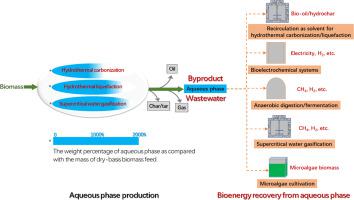Science of the Total Environment ( IF 9.8 ) Pub Date : 2020-09-17 , DOI: 10.1016/j.scitotenv.2020.142383 Lijian Leng , Weijin Zhang , Songqi Leng , Jie Chen , Lihong Yang , Hailong Li , Shaojian Jiang , Huajun Huang

|
Hydrothermal carbonization (HTC)/liquefaction (HTL)/gasification (HTG) are promising processes for biofuel production from biomass containing high moisture. However, wastewater, the aqueous phase (AP) byproduct from these hydrothermal processes, is inevitably produced in large amounts. The AP contains more than 20% of the biomass carbon, and the total organic carbon in AP is as high as 10–20 g/L. The treatment and utilization of AP are becoming a bottleneck for the industrialization of hydrothermal technologies. The major challenges are the presence of various inhibitory substances and the high complexity of AP. Bioenergy recovery from AP has attracted increasing interest. In the present review, the compositions and characteristics of AP are first presented. Then, the progress in recovering bioenergy from AP by recirculation as the reaction solvent, anaerobic digestion (AD), supercritical water gasification (SCWG), microbial fuel cell (MFC), microbial electrolysis cell (MEC), and microalgae cultivation is discussed. Recirculation of AP as reaction solvent is preferable for AP from biomass with relatively low moisture; AD, MFC/MEC, and microalgae cultivation are desirable for the treatment of AP produced from processing biomass with low lignin content at relatively low temperatures; SCWG is widely applicable but is energy-intensive. Finally, challenges and corresponding strategies are proposed to promote the development of AP valorization technologies. Comprehensive analysis of AP compositions, clarification of the mechanisms of valorization processes, valorization process integration detoxification of AP, polycultures and co-processing of AP with other waste, enhancement in pollutant removal, scaling-up performance, and the techno-economic analysis and life-cycle assessment of valorization systems are promising directions in future investigations.
中文翻译:

从水热处理生物质产生的废水中回收生物能源:进展,挑战和机遇
水热碳化(HTC)/液化(HTL)/气化(HTG)是从含高水分的生物质生产生物燃料的有前途的过程。但是,不可避免地会大量产生废水,这些水热过程产生的水相(AP)副产品。AP含有超过20%的生物质碳,AP中的有机碳总量高达10–20 g / L。AP的处理和利用正成为水热技术产业化的瓶颈。主要的挑战是各种抑制物质的存在和AP的高度复杂性。从AP回收生物能源引起了越来越多的兴趣。在本综述中,首先介绍了AP的组成和特性。然后,讨论了通过再循环作为反应溶剂,厌氧消化(AD),超临界水气化(SCWG),微生物燃料电池(MFC),微生物电解池(MEC)和微藻培养从AP中回收生物能的进展。从水分相对较低的生物质中,AP作为反应溶剂的再循环是优选的。AD,MFC / MEC和微藻培养对于在相对较低的温度下处理木质素含量低的生物质制得的AP十分理想。SCWG广泛适用,但耗能大。最后,提出了挑战和相应的策略,以促进AP评估技术的发展。对AP成分进行综合分析,阐明AP的增值过程机理,AP的增值过程综合解毒,



























 京公网安备 11010802027423号
京公网安备 11010802027423号